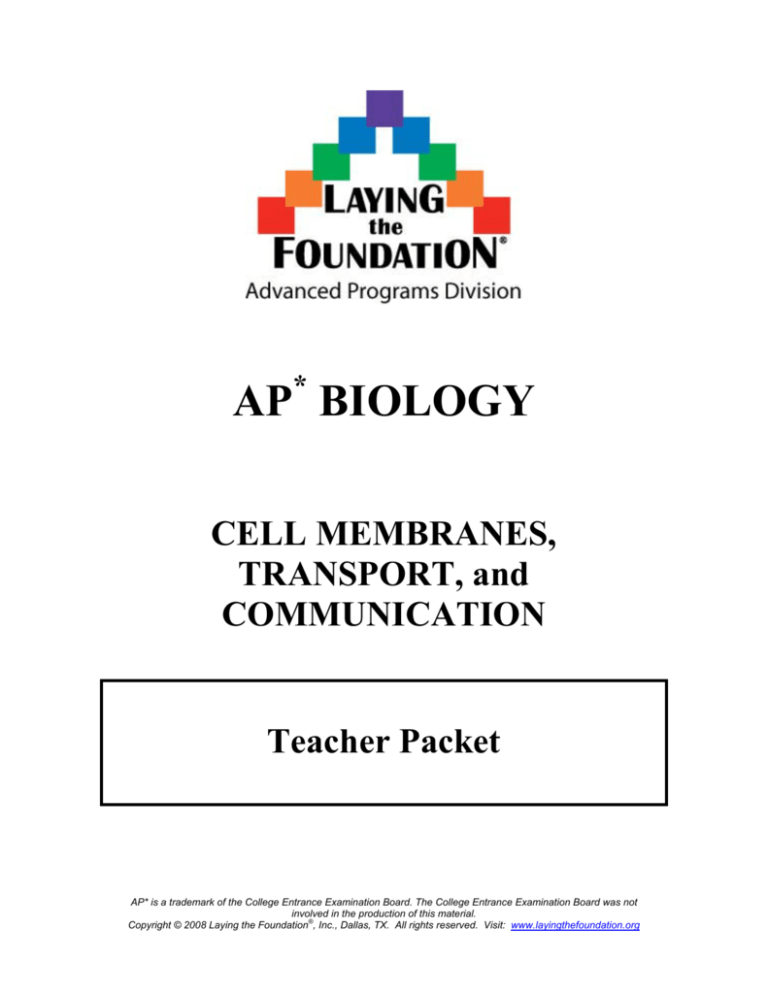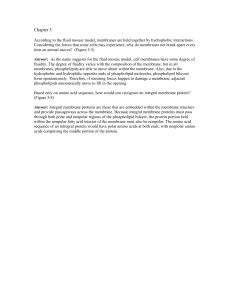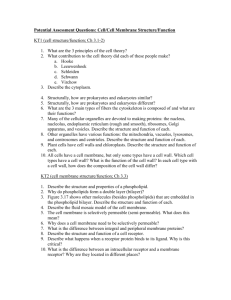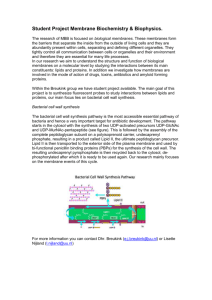
*
AP BIOLOGY
CELL MEMBRANES,
TRANSPORT, and
COMMUNICATION
Teacher Packet
AP* is a trademark of the College Entrance Examination Board. The College Entrance Examination Board was not
involved in the production of this material.
®
Copyright © 2008 Laying the Foundation , Inc., Dallas, TX. All rights reserved. Visit: www.layingthefoundation.org
Cell Membranes, Transport and Communication
Objective
To review the student on the concepts and processes necessary to successfully answer
questions over membranes as well as cellular transport and communication.
Standards
Photosynthesis is addressed in the topic outline of the College Board AP Biology Course
Description Guide as described below.
I. Molecules & Cells
B. Cells
Prokaryotic & Eukaryotic Cells
Membranes
Subcellular organization
Cell Cycle and its regulation
AP Biology Exam Connections
Membranes, transport, and communication are tested every year on the multiple choice
and consistently make up portions the free response section of the exam. Of the topics
covered in this section, membrane protein function and forms of transport seem to
dominate. As with many AP Biology free response, these topics are often intertwined
with other topics. Free response questions from this section also “spill over” into nervous
and endocrine system as well. The list below identifies free response questions that have
been previously asked over these topics. Free response questions on this topic are
common. These questions are available from the College Board and can be downloaded
free of charge from AP Central http://apcentral.collegeboard.com.
Free Response Questions
2005- Questions 4 (lab)
2008- Question 1 (b)
(form b)
2007- Question 1 (b)
2006- Question 2 (c), (d)
2003- Question 3 (a)
2002- Question 4 (lab)
AP* is a trademark of the College Entrance Examination Board. The College Entrance Examination Board was not
involved in the production of this material.
®
Copyright © 2008 Laying the Foundation , Inc., Dallas, TX. All rights reserved. Visit: www.layingthefoundation.org
Cell Membranes, Transport, and Communication
PHOSPHOLIPIDS
Triglyceride
Phospholipid
ÆPhospholipids containing polar phosphate heads and nonpolar lipid tails are derived from glycerol based fatty
acid chains.
ÆDue to their amphipathic (polar and nonpolar) nature, they congregate into bilayer sheets that form spheres when
placed in water.
ÆThe inner and outer leaflets of the bilayer may be and usually are composed of different phospholipid types.
ÆThese phospholipid bilayers are generally permeable to very small nonpolar substances.
ÆMembrane fluidity is different from one cell type to another, structure follows function. Membrane fluidity is
primarily controlled in two ways
The presence of cholesterol may increase or decrease fluidity depending on temperature ((high temp = more
solid, low temp = less solid)
The degree of lipid saturation. Highly saturated phospholipids tend to be more solid while the unsaturated
phospholipids tend to be more liquid.
Membranes: More than a simple phospholipid bilayer, it’s a fluid mosaic!
Æ Proteins may be classified based on location or function
ÆLocation
Integral or transmembrane proteins are embedded in
and typically traverse the entire membrane.
Peripheral proteins are associated with the inner or
outer leaflet only.
ÆThe order of amino acids will determine the placement of
polar and nonpolar regions. The completed protein will
have regions complimentary to the phospholipids around it
(primarily polar periphery + primarily nonpolar central
regions).
ÆThe appearance of these large proteins “floating” among
the phospholipids is the reason for the “fluid mosaic”
designation.
®
Copyright © 2008 Laying the Foundation , Inc., Dallas, TX. All rights reserved. Visit: www.layingthefoundation.org
Cell Membranes, Transport, and Communication
ÆFunction (more in later sections)
Carriers, Channels/Pores
Receptors
Enzymes
Anchor (anchoring cytoskeletal
elements for example or cell to cell)
Cell to cell recognition sites
(glycoproteins)
Osmosis, Diffusion, & Tonicity
ÆThe passage of substances along the concentration gradient
(from [high] to [low]) is the passive process of diffusion. If the
substance happens to be H2O, the process is osmosis. These
processes are passive and therefore do not require cellular energy.
ÆCell tonicity is named based on solute concentration. These
terms are relative, when one location is hypertonic another
location must be hypotonic
Hypertonic- higher solute concentration, Hypotonic-lower
solute concentration, Isotonic- equal solute concentrations
Significance: H2O can move passively between
phospholipids and through aquaporins. Solute
concentrations will determine which way that H2O will
move.
ÆIf the “cell” on the right is permeable only to water, which way
will water flow?
ÆBe it the need for turgor pressure in plants or the maintenance of
a particular chemical environment in an animal cell, osmosotic
balance is important to homeostasis.
ÆProtists may extrude H2O through contractile vacuoles while
other eukaryotes may use channels and pumps.
®
Copyright © 2008 Laying the Foundation , Inc., Dallas, TX. All rights reserved. Visit: www.layingthefoundation.org
Cell Membranes, Transport, and Communication
Bulk Transport
ENDOCYTOSIS:
Phagocytosis
“cell eating”
ENDOCYTOSIS:
Pinocytosis
“cell drinking”
ENDOCYTOSIS:
Receptor mediated
endocytosis
EXOCYTOSIS:
“exiting” the cell
Functional
significance
ÆPhagocytosis and Pinocytosis are quick ways to bring in large quantities of materials. Receptor mediated
endocytosis (with the aid of clathrins) adds a layer of specificity. For additional specificity a mode of selective
transport must be used
ÆExocytosis allows the cell to excrete waste, hormones such as insulin, and other substances.
Selective Transport
ÆActive transport
ÆFacilitated diffusion: “helped” diffusion
Carriers are specific, active (require energy), and
Carriers are specific, passive, and saturable
Carriers have an arrangement of amino acids unique
saturable
to a specific substance
Often have “pump” in the name
Example: aquaporin
Examples: Na+/K+ pumps found in neurons,
proton pumps found in the ETC.
ÆAdvantage: Selective transport mechanisms are more accurate than bulk transport mechanisms.
ÆDisadvantage: Selective transport mechanisms are slower than bulk transport mechanisms
Cell Signaling
THREE STAGES OF A SIGNAL-TRANSDUCTION
Ædirect contact: cell / cell recognition, gap junctions
CASCADE
Æparacrine signaling: local only
1. Reception- signal molecule (ligand) binding to
example: growth factors
receptor
Æsynaptic signaling: neurons only
2. Transduction- usually a change in shape, getting
neurotransmitters
signal into form that can illicit response
Æendocrine signaling: long distances
3. Response
example: hormones
Receptor Types: Mechanisms of Cell Signaling
Intracellular Receptors
ÆLocation- The receptor is located inside the cell.
ÆOperating procedures- Nonpolar ligands (such as
steroid based hormones) can diffuse through the lipid
bilayer to reach the internal receptor. The activated
receptor will eventually (directly or indirectly) effect
transcription or translation.
TYPES OF SIGNALING
®
Copyright © 2008 Laying the Foundation , Inc., Dallas, TX. All rights reserved. Visit: www.layingthefoundation.org
Cell Membranes, Transport, and Communication
Cell Surface Receptors
ÆLocation- The receptor is located on the cell surface.
ÆA signal transduction cascade ensues.
Why a cascade?
Each step of signal transduction may activate many
proteins in the next step amplifying the signal.
Each step is a “yes/no” point of control
ÆSecond messengers may be used as well. These are
soluble nonproteins (cAMP, Ca2+).
ÆG linked proteins are a “diffusible signal in the
cytoplasm”; however, they still stay near the cell surface
and usually activate a cell surface enzyme. G linked
proteins are activated by GTP, hence the name.
®
Copyright © 2008 Laying the Foundation , Inc., Dallas, TX. All rights reserved. Visit: www.layingthefoundation.org
Cell Membranes, Transport, and Communication
Multiple Choice
1. The membrane of an animal cell would be impermeable to all of the following EXCEPT
I. a large and primarily polar protein
II. a small lipid based molecule
III. starch
(A) I only
(B) II only
(C) III only
(D) I and II only
(E) I and III only
B
Small lipid soluble substances are able to traverse the phospholipid bilayer. Large substances and polar
substances are typically not able to cross with the aid of proteins.
2. The passive transport of an ion through a protein carrier into a cell represents which of the following?
(A) facilitated diffusion
(B) osmosis
(C) exocytosis
(D) phagocytosis
(E) active transport
A
Of the options listed, only A & B are passive. The movement of an ion cannot be osmosis (diffusion of
water). In this case, a protein carrier helps (facilitates) the passive movement (diffusion) of ions.
3. All of the following statements regarding membranes are correct EXCEPT
(A) Polar heads of phospholipids are located on the periphery of the cell membrane.
(B) Cell surface receptor proteins transfer small polar substances into the cell.
(C) Peripheral proteins may display enzymatic functions.
(D) Phospholipids are amphipathic.
(E) Glycoproteins are involved in cell-to cell recognition.
B
Receptor proteins transfer information into a cell, but unlike carriers they do not transfer an actual
molecule into the cell.
4. Which of the following signaling mechanisms represent a correctly matched pair?
(A) endocrine- neural communication
(B) synaptic- intravenous communication
(C) paracrine- communication with nearby, surrounding cells
(D) gap junction- communication via hormones
(E) receptor- substrate communication
C
Paracrine signaling involves nearby cells.
®
Copyright © 2008 Laying the Foundation , Inc., Dallas, TX. All rights reserved. Visit: www.layingthefoundation.org
Cell Membranes, Transport, and Communication
Question 5 and 6 refers to the data table and picture of the membrane experiment below
“Cell”
0.1 M sucrose
0.2 M glucose
5% starch
Environment
0.2 M sucrose
0.1 M glucose
2% starch
5. Assume that the “cell” above is permeable to sucrose, glucose, and water but impermeable to starch.
Which of the following statements is correct?
(A) Starch will diffuse into the cell.
(B) Starch will diffuse out of the cell.
(C) There will be no net movement of glucose
(D) Glucose will diffuse into the cell
(E) Sucrose will diffuse into the cell
E
The question stem tells the reader that the “cell” is impermeable to starch. The concentration gradient is
such that sucrose will move from higher [0.2M] concentration outside of the cell to lower [0.1M] inside
the cell
6. Assume the “cell” is permeable to water only. If the cell contains a 0.3 M solution of glucose and the
environment contians a 0.1 M solution of glucose, which of the following statements would be true?
(A) The cell will decrease in volume.
(B) Glucose will enter the “cell.”
(C) Pinocytosis will occur.
(D) There would be a net movement of water into the “cell.”
(E) There would be no net movement of water.
D
Water will move in to “dilute” the higher concentration of glucose inside the “cell.”
®
Copyright © 2008 Laying the Foundation , Inc., Dallas, TX. All rights reserved. Visit: www.layingthefoundation.org
Cell Membranes, Transport, and Communication
Questions 7-10 refer to the diagram of a cell membrane below.
7. Contains both polar and nonpolar regions while lacking sulfur
E
Phospholipids contain polar heads and nonpolar tails
8. Responsible for maintaining the shape of the cell.
C
The cytoskeleton contributes to the shape of the cell.
9. Allows information to pass through the membrane without actually allowing substances to penetrate the
membrane.
D
Receptors allow information to pass without allowing the ligand to actually enter the cell.
10. Primarily responsible for cell-to-cell recognition
A
Glycoproteins are involved in cell-to cell recognition (immune system, etc.)
®
Copyright © 2008 Laying the Foundation , Inc., Dallas, TX. All rights reserved. Visit: www.layingthefoundation.org
Cell Membranes, Transport, and Communication
Free Response
1. The cell membrane is much more than a passive barrier of the cell.
(A) Describe in detail the fluid mosaic model of the cell membrane.
(6 pt maximum)
__phospholipid description (polar head, nonpolar tails)
__phospholipid bilayer (must explain significance with reference to polarity)
__cholesterol: effects membrane fluidity
__transmembrane proteins span the entire membrane
__role of a transmembrane protein (carrier, receptor, etc.)
__peripheral protein
__role of a peripheral protein (anchor, enzyme, etc.)
__glycolipid OR cell surface marker
__role of glycolipid (identify cell as “self” to the immune system, etc)
(B) Describe and give an example for each of the following:
i) a bulk transport mechanism (2 pt maximum)
__phagocytosis: cell “eating” OR taking in larger solutes
__pinocytosis: cell “drinking” OR taking in smaller solutes
__receptor mediated endocytosis: receptor coated invaginations
__valid example #1: such as immune system phagocytosis description
__valid example #2: cell taking fluids in to maintain osmotic balance
ii) facilitated diffusion (2 pt maximum)
__passive OR movement from high to low concentration with the aid of a protein or carrier/channel
__usually a water filed pore to allow polar molecules to pass through
__example: aquaporins or other valid example
iii) active transport (2 pt maximum)
__transporting against the concentration gradient OR so that “stockpiling” of molecules can take place
__requires energy or ATP
__example: proton pumps, Na+/K+ pumps, etc
*must earn a point all 3 sections of part B in order to earn a 10 overall.
®
Copyright © 2008 Laying the Foundation , Inc., Dallas, TX. All rights reserved. Visit: www.layingthefoundation.org
Cell Membranes, Transport, and Communication
Free Response
2. Cell receptors play an integral role in cellular communication.
A. Briefly list and describe the steps of a signal transduction cascade
__Reception- ligand binding
__Transduction- change in shape of proteins or activation or phosphorylation of proteins
__Response- cellular response to the message (ie cell division if the “message” was a growth factor)
B. Describe and discuss the mechanism by which a cell surface receptor sends a message to the interior of the cell.
__ligand is typically NOT lipid soluble, so it must bind to a cell surface receptor
__receptor is often linked to a peripheral protein
__receptor will create a biochemical cascade (signal transduction cascade) activating many proteins
__second messengers may be involved (Ca2+, cAMP, etc.)
__each step of the cascade is a “control” step where the process may be halted by other proteins
__each step may result in amplification: 1 signal activates 10 proteins which each activate 10, etc.
__mention of G proteins in proper context (associated with membrane, GTP dependent, etc.)
C. Describe and discuss the role of a receptor located in the cytosol with respect to cellular communication.
__Nonpolar ligands are able to diffuse into the cytosol
__receptors are activated and usually enter the nucleus to effect transcription
®
Copyright © 2008 Laying the Foundation , Inc., Dallas, TX. All rights reserved. Visit: www.layingthefoundation.org









